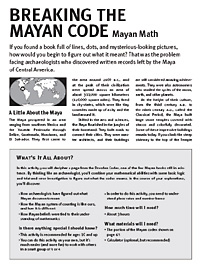
|
|

|
|
| From " Math and Science Across Cultures " by Maurice Bazin, Modesto Tamez, and the Exploratorium Teacher Institute |
Breaking the Mayan Code:
Mayan Math
You can
download this activity in PDF format
.
![]() Get the free Adobe Acrobat Reader
Get the free Adobe Acrobat Reader
If you found a book full of lines, dots, and mysterious-looking pictures, how would you begin to figure out what they meant? That was the problem facing archeologists who discovered written records left by the Maya.
Not many Mayan writings still exist, as many of them were destroyed by Spanish conquistadores. The writings that do exist represent a number of different languages and a writing system that used glyphs, or pictures, to represent words and syllables.
The Maya developed a sophisticated number system that they used to record possessions, dates, and astronomical observations. In this activity, you'll begin to decode the number system as it's written in a document known as the "Dresden Codex."
Grade Level
Grade 5 and up
National Standards Addressed
Grades 5–8
History and Nature of Science: History of Science
Grades 9–12
History and Nature of Science: Historical Perspectives
• Principles and Standards for School Mathematics
http://illuminations.nctm.org/info/standards.asp
Grades 6–8
Problem Solving
Communication
Grades 9–12
Numbers and Operations
Key Concepts
Numerical bases, number systems
Background Science
Learn about number bases
From NRICH, University of Cambridge
http://nrich.maths.org/public/viewer.php?
obj_id=1368&part=index&refpage=monthindex.php
Mayan Numerals
From the Department of Mathematics and Statistics, Univeristy of Regina
http://mathcentral.uregina.ca/RR/database/RR.09.00/hubbard1/
Mayan Arithmetic
From Mathforum.org
http://mathforum.org/k12/mayan.math/
Ideas for Discussion
• Ask someone who speaks a different language from your own to write something down for you. How different is her or his language from your own? Does it have a different alphabet or special marks around letters or words? What direction do you read it in? What other similarities and differences do you see?
•
Many ancient writings, including Mayan ones, use glyphs, or pictures, that stand for words. If you were to invent such a writing system, what picture would you use for "hand"? How about "apple"? What kind of picture would you use for "color" or "sour" or "comfortable"? What is different about representing words like these last three?
• What systems do we use in the modern world to convey numerical ideas? If a Mayan person were to look at a checkbook ledger, what clues might they see to help them figure out our number system?
Going Further
• Computers operate on a base 2 number system, rather than on the base 10 system we use for most other things. You can learn more about the base 2, or binary, number system from this website from Grinnell College:
http://www.math.grin.edu/~rebelsky/Courses/152/97F/Readings/student-binary.html
and from this posting on MathForum.org:
http://mathforum.org/library/drmath/view/54311.html